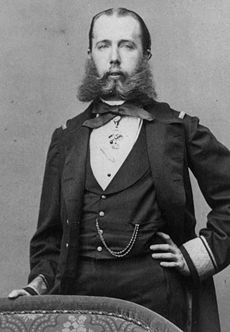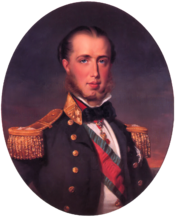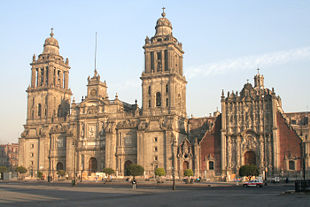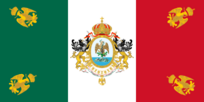Maximilian I of Mexico
| Maximilian I | |
|---|---|
| Emperor of Mexico | |
 |
|
| Portrait of Maximilian I of Mexico | |
| Emperor of Mexico | |
| Reign | 10 April 1864 – 15 May 1867 |
| Predecessor | Empire declared |
| Successor | Empire abolished |
| Coronation | 10 April 1864 |
| Regent | José Mariano Salas Juan Nepomuceno Almonte Pelagio Antonio de Labastida y Dávalos |
| Mexican head of state | |
| Predecessor | Félix María Zuloaga |
| Successor | Benito Juárez |
| Spouse | Charlotte of Belgium |
| Issue | |
| Prince Augustine(adoptive) Prince Salvador (adoptive) |
|
| Full name | |
| Ferdinand Maximilian Joseph | |
| Titles and styles | |
| HIM The Emperor of Mexico HI&RH Prince Imperial Archduke Maximilian of Austria, Prince Royal of Hungary and Bohemia HE The Viceroy of Lombardy-Venetia |
|
| Father | Archduke Franz Karl of Austria |
| Mother | Princess Sophie of Bavaria |
| Born | July 6, 1832 Schönbrunn, Vienna, Austria |
| Died | June 19, 1867 (aged 34) Cerro de las Campanas, Querétaro, Mexico |
| Burial | Imperial Crypt, Vienna, Austria |
Maximilian I, Emperor of Mexico (Emperador Maximiliano I de México) (6 July 1832 – 19 June 1867) (born Ferdinand Maximilian Joseph) was a member of Austria's Imperial Habsburg-Lorraine family. With the backing of Napoleon III of France and a group of Mexican monarchists, he was proclaimed Emperor of Mexico on 10 April 1864. Many foreign governments refused to recognize his government, especially the United States; this ensured the success of Republican forces led by Benito Juárez, and Maximilian was executed, after his capture by Republicans, in Santiago de Querétaro in 1867.
Contents |
Early life

Maximilian was born in Schönbrunn, Vienna, Austria, the second son of Archduke Franz Karl of Austria and his wife Sophie Friederike Dorothee Wilhelmine, Princess of Bavaria. His siblings were Emperor Franz Josef of Austria, Karl Ludwig, Archduchess Maria Anna Caroline Pia and Archduke Ludwig Viktor. Maximilian was born as His Imperial and Royal Highness Ferdinand Maximilian Joseph, Prince Imperial and Archduke of Austria, Prince Royal of Hungary and Bohemia.
There is well-documented suspicion that Maximilian was not the product of a union between Princess Sophie and Franz Karl. Many Europeans, and Viennese in particular, suspected that he was actually fathered by Napoleon II (son of Napoleon I and Marie Louise of Austria as Napoleon Francois Joseph Charles Bonaparte, also known as the Duke of Reichstadt). Those who subscribe to this belief cite the unnaturally close relationship that existed between Sophie and Napoleon II (it was said that Sophie never recovered after his death and that she blamed it on Metternich for the rest of her life) and that, from birth, Maximilian's stature resembled Napoleon II's more than that of Franz Karl, his older brother, and his younger brothers.[1][2] He was a particularly clever boy, showing considerable taste for the arts and displaying an early interest in science, especially botany. He was trained for the navy, and threw himself into this career with so much zeal that he quickly rose to high command, and was instrumental in creating the naval port of Trieste and the fleet with which Admiral Wilhelm von Tegetthoff won his victories in the Italian War. Very much influenced by the progressive ideas in vogue at the time, he had some reputation as a liberal, and this led, in February 1857, to his appointment as viceroy of the Kingdom of Lombardy-Venetia.
He married his second cousin Princess Charlotte of Belgium (also known as Empress Carlota of Mexico), daughter of Leopold I, King of the Belgians and of Louise-Marie of France, on 27 July 1857, in Brussels, Belgium. They had no children.
They lived as the Austrian regents in Milan until 1859 when Emperor Franz Josef dismissed Maximilian. The emperor was angered by the liberal policies pursued by his brother in Italy. Shortly after Maximilian's dismissal, Austria lost control of most of its Italian possessions. He then retired into private life, chiefly at Trieste, near which he built the beautiful castle Miramare.
Offer of a Mexican crown

In 1859 he was first approached by Mexican monarchists, led by local nobleman José Pablo Martínez del Río, with a proposal to become the Emperor of Mexico. He did not accept at first, but sought to satisfy his restless desire for adventure with a botanical expedition to the tropical forests of Brazil. However, after the French intervention in Mexico, under pressure from Napoleon III and after General Élie-Frédéric Forey's capture of Mexico City and the plebiscite which confirmed his proclamation of the empire, he consented to accept the crown in 1863 (Maximilian was not told of the dubious nature of the plebiscite, which was held while French troops were occupying most of the territory). His decision involved the loss of all his noble rights in Austria, though he was not informed of this until just before he left. Archduchess Charlotte was thereafter known as "Her Imperial Majesty Empress Carlota".
Emperor of Mexico

Maximilian landed at Veracruz on 28 May 1864 with the backing of Mexican conservatives and Napoleon III; but from the very outset he found himself involved in serious difficulties since the Mexican liberals, led by Benito Juárez, refused to recognize his rule. There was continuous warfare between his French troops and the Republicans.
The Imperial couple chose as their seat Mexico City. The Emperor and Empress set up their residence at Chapultepec Castle, located on the top of a hill formerly at the outskirts of Mexico City that had been a retreat of Aztec emperors. Maximilian ordered a wide avenue cut through the city from Chapultepec to the city center; originally named Avenue of the Empress, it is today Mexico City's famous Paseo de la Reforma (The Reform Promenade). They made plans to be crowned at the Catedral Metropolitana, but the coronation was never actually carried out, due to constant instability of the regime.
As Maximilian and Carlota had no children, they adopted Agustín de Iturbide y Green and his cousin Salvador de Iturbide y de Marzán, both grandsons of Agustín de Iturbide, who had briefly reigned as Emperor of Mexico in the 1820s. They gave young Agustín the title of "His Highness, the Prince of Iturbide" and intended to groom him as heir to the throne.
To the dismay of his conservative allies, Maximilian upheld several liberal policies proposed by the Juárez administration – such as land reforms, religious freedoms, and extending the right to vote beyond the landholding class. At first Maximilian offered Juárez an amnesty if he would swear allegiance to the crown, which Juárez refused. Later Maximilian ordered all captured followers of Juárez to be shot, in response to the republican practice of executing anyone who was a supporter of the Empire. In the end, it proved to be a tactical mistake that only exacerbated opposition to his regime.
After the end of the American Civil War the United States began supplying arms to the republicans. By 1866 the imminence of Maximilian's abdication was apparent to almost everyone outside Mexico.


In 1866 Napoleon III withdrew his troops in the face of Mexican resistance and U.S. opposition under the Monroe Doctrine, but the main reason was to increase his military contingent at home to face the ever growing German power of Bismarck. Carlota travelled to Europe, seeking assistance for her husband's regime in Paris and Vienna and, finally, in Rome from Pope Pius IX. Her efforts failed, and she suffered a deep emotional collapse (some say insanity) and never went back to Mexico. After her husband was executed by republicans the following year, she spent the rest of her life in seclusion, first at Miramare Castle near Trieste, Italy, and then at Bouchout Castle in Meise, Belgium, where she died on 19 January 1927.
Downfall
Though urged to abandon Mexico by Napoleon III himself, whose withdrawal from Mexico was a great blow to the Mexican Imperial cause, Maximilian refused to desert his followers. Withdrawing, in February 1867, to Santiago de Querétaro, Querétaro Arteaga, he sustained a siege for several weeks, but on May 11 resolved to attempt an escape through the enemy lines. However the city fell on 15 May 1867, before he could carry out this plan, and he was captured. Following a court-martial, he was sentenced to death. Many of the crowned heads of Europe and other prominent figures (including the eminent liberals Victor Hugo and Giuseppe Garibaldi) sent telegrams and letters to Mexico pleading for Maximilian's life to be spared, but Juárez refused to commute the sentence, believing that it was necessary to send a message that Mexico would not tolerate any government imposed by foreign powers.
The sentence was carried out in the Cerro de las Campanas on 19 June 1867, when Maximilian was executed (together with his generals Miguel Miramón and Tomás Mejía) by a firing squad. His last words were reported to be "Mexicans! Today I die for a fair cause: the freedom and independence of Mexico. May God allow my spilling blood to put an end forever to the disgraces of my new homeland. ¡Viva México!". Although he bribed the seven riflemen not to shoot him in the head, one did it anyway. Maximilian's body was embalmed and displayed in Mexico before being buried in the Imperial Crypt in Vienna, Austria, early the following year.
Titles from birth
Titles Maximilian held from birth, in chronological order:
- His Imperial and Royal Highness Archduke Maximilian of Austria, Prince of Hungary and Bohemia (6 July 1832 – 10 April 1864)
- His Imperial Majesty Maximilian I, The Emperor of Mexico (10 April 1864 – 19 June 1867)
Ancestry
| Ancestors of Maximilian I of Mexico | ||||||||||||||||||||||||||||||||||||||||||||||||||||||||||||||||||||||||||||||||||||||||||||||||||||||||||||||||||||||||||||||||||||||||||||||||||||||||||||||||||||||||||||||||||||||||||||||||||||||||||||||||||||||||||||||||||||||||||||||||||||||||||||||||||||||||||||||||||||||||||||||||||||||||||||||||||||||||||||||||||||||||||||||||||||||||||||||||||||||||||||||||||||||||||||||||||||||||||||||||||||||||||||||||||||||||||||||||||||||||||||||||||||||||||||||||||||||||||||||||||||||||||||||||||||||||||||||||||||||||||||||||||||||||||||||||||
|---|---|---|---|---|---|---|---|---|---|---|---|---|---|---|---|---|---|---|---|---|---|---|---|---|---|---|---|---|---|---|---|---|---|---|---|---|---|---|---|---|---|---|---|---|---|---|---|---|---|---|---|---|---|---|---|---|---|---|---|---|---|---|---|---|---|---|---|---|---|---|---|---|---|---|---|---|---|---|---|---|---|---|---|---|---|---|---|---|---|---|---|---|---|---|---|---|---|---|---|---|---|---|---|---|---|---|---|---|---|---|---|---|---|---|---|---|---|---|---|---|---|---|---|---|---|---|---|---|---|---|---|---|---|---|---|---|---|---|---|---|---|---|---|---|---|---|---|---|---|---|---|---|---|---|---|---|---|---|---|---|---|---|---|---|---|---|---|---|---|---|---|---|---|---|---|---|---|---|---|---|---|---|---|---|---|---|---|---|---|---|---|---|---|---|---|---|---|---|---|---|---|---|---|---|---|---|---|---|---|---|---|---|---|---|---|---|---|---|---|---|---|---|---|---|---|---|---|---|---|---|---|---|---|---|---|---|---|---|---|---|---|---|---|---|---|---|---|---|---|---|---|---|---|---|---|---|---|---|---|---|---|---|---|---|---|---|---|---|---|---|---|---|---|---|---|---|---|---|---|---|---|---|---|---|---|---|---|---|---|---|---|---|---|---|---|---|---|---|---|---|---|---|---|---|---|---|---|---|---|---|---|---|---|---|---|---|---|---|---|---|---|---|---|---|---|---|---|---|---|---|---|---|---|---|---|---|---|---|---|---|---|---|---|---|---|---|---|---|---|---|---|---|---|---|---|---|---|---|---|---|---|---|---|---|---|---|---|---|---|---|---|---|---|---|---|---|---|---|---|---|---|---|---|---|---|---|---|---|---|---|---|---|---|---|---|---|---|---|---|---|---|---|---|---|---|---|---|---|---|---|---|---|---|---|---|---|---|---|---|---|---|---|---|---|---|---|---|---|---|---|---|---|---|---|---|---|---|---|---|---|---|---|---|---|---|---|---|---|---|---|---|---|---|---|---|---|---|---|---|---|---|---|---|---|---|---|---|---|---|---|---|---|---|---|---|---|---|---|---|---|---|---|---|---|---|---|---|---|---|---|---|---|---|---|---|---|---|---|---|---|---|---|---|---|---|---|---|---|---|---|---|---|---|---|---|---|---|---|---|---|---|---|---|---|---|---|---|---|---|---|---|---|---|---|---|---|---|---|---|---|---|---|---|---|---|---|
|
||||||||||||||||||||||||||||||||||||||||||||||||||||||||||||||||||||||||||||||||||||||||||||||||||||||||||||||||||||||||||||||||||||||||||||||||||||||||||||||||||||||||||||||||||||||||||||||||||||||||||||||||||||||||||||||||||||||||||||||||||||||||||||||||||||||||||||||||||||||||||||||||||||||||||||||||||||||||||||||||||||||||||||||||||||||||||||||||||||||||||||||||||||||||||||||||||||||||||||||||||||||||||||||||||||||||||||||||||||||||||||||||||||||||||||||||||||||||||||||||||||||||||||||||||||||||||||||||||||||||||||||||||||||||||||||||||

Further reading
Maximilian's papers were published at Leipzig in 1867, in seven volumes, under the title Aus meinem Leben, Reiseskizzen, Aphorismen, Gedichte (In My Life: Travelogues, Aphorisms & Poems).
Other works:
- The Cactus Throne by Richard O'Connor, ISBN 0-380-00641-3
- The Crown of Mexico by Joan Haslip, ISBN 0-03-086572-7
- Maximilian and Juarez by Jasper Ridley, ISBN 1-84212-150-2
- La Corona de Sombra by Rodolfo Usigli ISBN-10: 0390891509 ISBN-13: 978-0390891501
- From Mexico to Miramar or, Across the Lake of Oblivion by C.M. Mayo, Massachusetts Review, December 2006
References
- ↑ Maximilian and Carlota by Gene Smith, ISBN 0245524185, ISBN 978-0245524189
- ↑ Maximilian and Juarez by Jasper Ridley, ISBN 0-89919-989-5
See also
- Archduke Ferdinand Maximilian was the subject of a 20 euro commemorative coin S.M.S. Novara coin minted in 16 June 2004. On the reverse, there is a dual portrait of the Archduke and of Commodore Bernhard von Wüllerstorf-Urbair, who commanded the Novara on her voyage of circumnavigation of the globe. In front of them, on the table, there is a large ship’s globe and instruments of navigation, along with a microscope (this was a scientific expedition).
- History of Mexico
- Habsburg
- Second Mexican Empire
Franz Liszt wrote a Funeral March in Maximilian's honour in 1867, which was published as No. 6 of Années de Pèlerinage, Troisieme Année in 1883.
In the 1939 film Juarez, Brian Aherne gave a very sympathetic portrayal of Maximilian. His portrayal in 1954's Vera Cruz, by George Macready, was less sympathetic.
Fernando del Paso's novel Noticias del Imperio concerns the life of Maximiliano I and Carlota during their reign in Mexico.
French composer Darius Milhaud wrote an opera entitled Maximilien, which was premiered at the Palais Garnier in 1932.
External links
- Imperial House of Austria
- Royal House of Belgium
- Imperial House of Mexico
- C.M. Mayo's Maximilian Page
- Recollections of my life by Maximilian I of Mexico Vol. I at archive.org
- Recollections of my life by Maximilian I of Mexico Vol. II at archive.org
- Recollections of my life by Maximilian I of Mexico Vol. III at archive.org
- Manet, The Execution Maximilian, Five Paintings 1867 - 1869
|
Maximilian I of Mexico
Cadet branch of the House of Habsburg
Born: July 6 1832 Died: June 19 1867 |
||
| Regnal titles | ||
|---|---|---|
| Vacant
Title last held by
Agustín I |
Emperor of Mexico 10 April 1864–15 May 1867 |
Monarchy abolished |
| Vacant
Title last held by
Franz Joseph I |
Viceroy of Lombardy-Venetia 1857–1859 |
Succeeded by Franz Joseph I in Venetia |
| Succeeded by Victor Emmanuel II in Lombardy |
||
| Political offices | ||
| Preceded by Juan Nepomuceno Almonte José Mariano Salas as Regents |
Mexican head of state as Emperor of Mexico 10 April 1864–15 May 1867 |
Succeeded by Benito Juárez as President of Mexico |
| Titles in pretence | ||
| Vacant
Title last held by
Prince Agustin Jerónimo |
— TITULAR — Emperor of Mexico May 15–19 June 1867 |
Succeeded by Prince Agustín |
 |
| Pretenders to the Mexican throne since 1823 |
|---|
|
|
|
Emperor Agustín I (1823-1824) |
|
|
|
Emperor Maximilian I (1867) |
|
|